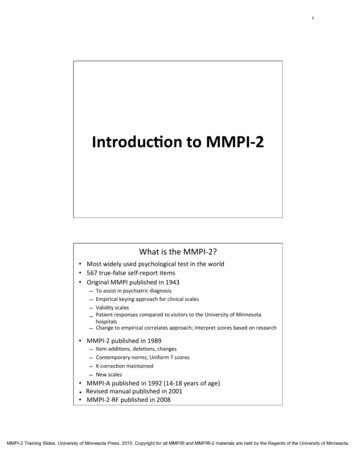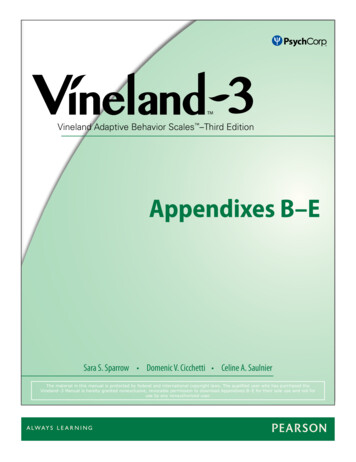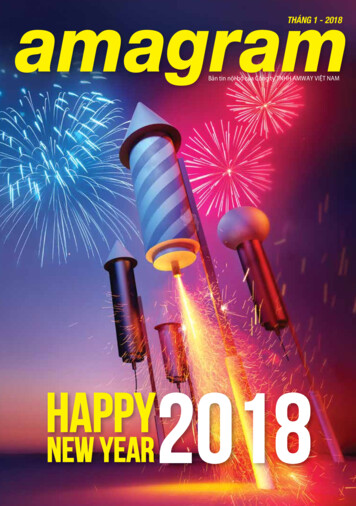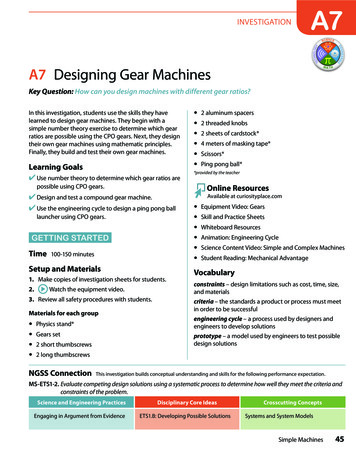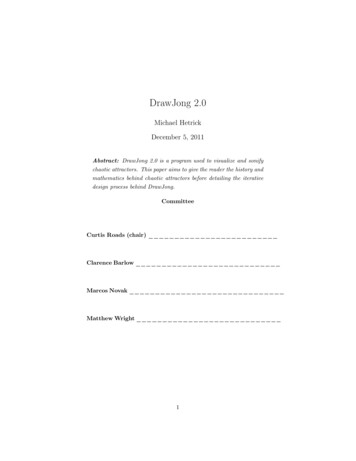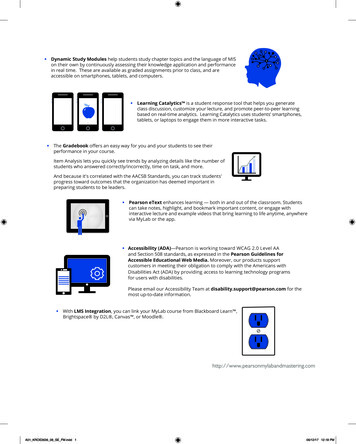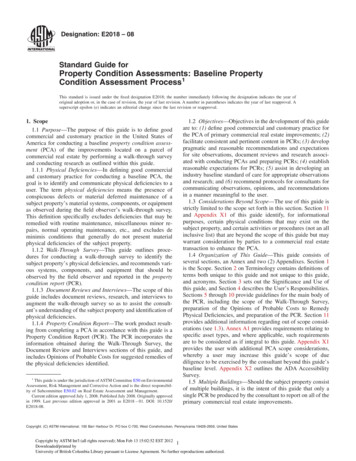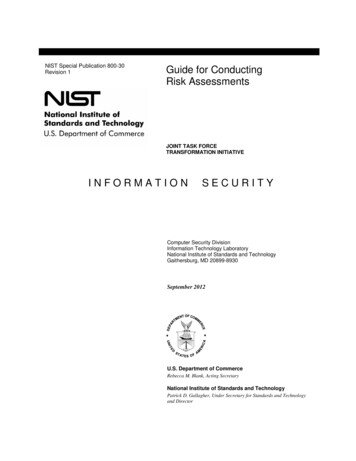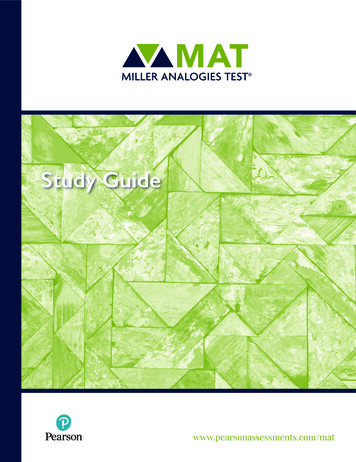
Transcription
Study Guidewww.pearsonassessments.com/mat
For inquiries or matCopyright 2021 NCS Pearson, Inc. All rights reserved.Warning: No part of this publication may be reproduced or transmitted in any form or by anymeans, electronic or mechanical, including photocopy, recording, or any information storageand retrieval system, without the express written permission of the copyright owner.Pearson, Miller Analogies Test, MAT, and the MAT logo are trademarks in the U.S. and/orother countries of Pearson PLC or its affiliate(s).NCS Pearson, Inc. 5601 Green Valley Drive Bloomington, MN 55437Produced in the United States of America.v.A Product Number 66204
Table of ContentsThe Miller Analogies Test Study Guide 1The Structure of MAT Analogies 1Solving MAT Analogies 2Types of Relationships in MAT Analogies 2The Content of MAT Analogies 6Test-Taking Strategies for the MAT 9Sample Analogies 11Copyright 2021 NCS Pearson, Inc. All rights reserved. 1-800-622-3231 Table of Contentsiii
The Miller Analogies Test Study GuideThe Miller Analogies Test (MAT) is a high-level test of analytical ability that requires the solution of problemsstated as analogies. The MAT consists of 120 partial analogies that are to be completed in 60 minutes. The testmeasures your ability to recognize relationships between ideas, your fluency in the English language, and your generalknowledge of the humanities, natural sciences, mathematics, and social sciences.The Structure of MAT AnalogiesAn analogy is a statement that suggests two terms are related to each other in the same way that two other terms arerelated to each other. The MAT analogy items are written as equations in the form “A : B :: C : D.” This can be readas either “A is related to B in the same way that C is related to D” or as “A is related to C in the same way as B isrelated to D.”In each MAT analogy item, one term is missing and you must choose which of the four answer options correctlycompletes the analogy. For example:Plane : Air :: Car : (a. motorcycle, b. engine, c. land, d. atmosphere)The first step in solving a MAT analogy is to decide which two of the three given terms form a complete pair. In theexample, this could either be “Plane is related to Air” (the first term is related to the second term) or “Plane is relatedto Car” (the first term is related to the third term).On the MAT, the first term is never related to the fourth term. Therefore, this example could NOT be read as“Plane is related to (a. motorcycle, b. engine, c. land, d. atmosphere).”The solution to a MAT analogy item requires that you select the option that forms a second pair of terms that are in thesame relationship to each other as the terms in the complete pair. In this example, none of the available options forma second pair of terms if the analogy is seen as a relationship between two vehicles—Air is definitely not a vehicle.However, when the complete pair is seen as “Plane travels on Air,” the second pair, and the correct answer, becomesobvious as “Car travels on c. land”:Plane : Air :: Car : (a. motorcycle, b. engine, c. land, d. atmosphere)The missing term in a MAT analogy—the term represented by the four answer options—could be in any one of thefour positions. All of the possible formats for MAT analogies are represented in the following examples: alt : Hypertension :: Sugar : (a. cholesterol, b. carbohydrates, c. hyperthyroidism, d. diabetes)SSolution— The answer is “d. diabetes”; salt contributes to or aggravates the symptoms of hypertension, andsugar does the same for diabetes. eek : Find :: (a. locate, b. book, c. retrieve, d. listen) : HearSSolution— The answer is “d. listen”; one seeks something in order to find it, and one listens to something inorder to hear it.Copyright 2021 NCS Pearson, Inc. All rights reserved. 1-800-622-3231 The Miller Analogies Test Study Guide1
I nduction : (a. confirmation, b. graduation, c. ordination, d. resistance) :: Soldier : PriestSolution— The answer is “c. ordination”; induction is the ceremony for becoming a soldier, and ordination isthe ceremony for becoming a priest. (a. cure, b. epidemic, c. immunity, d. patient) : Shade :: Inoculation : ParasolSolution— The answer is “c. immunity”; a parasol produces shade, and an inoculationproduces immunity.Regardless of how the terms in a MAT analogy are presented, there is only one valid and logical relationship thatexists between each pair of terms.Solving MAT AnalogiesThere are four basic steps in solving a MAT analogy:1. Read the three given terms in the analogy carefully.2. Determine the relationships between the two possible pairs among the three given terms.3. W ithout looking at the answer options, think of a fourth term that would complete an analogy along with thethree given terms. You may be able to identify more than one possible analogy that would include the threegiven terms.4. E xamine the answer options, and select the option that most closely resembles your idea of a term that wouldcomplete the analogy.If none of the answer options seems to form an analogy, rethink the relationship you identified in the given terms. Youmay need to repeat the steps to arrive at an acceptable answer.For example, consider the following:Pint : (a. cup, b. quart, c. liter, d. gallon) :: 1 : 2Reading the three given terms in this analogy may not initially seem to provide obvious clues as to which option willcomplete it, until you consider the relationship of 1 to 2, a likely candidate for a complete pair. These two numeralscan be seen as either a sequence of numbers or as one representing twice the value of the other.If the relationship is seen as a sequence, then none of the answer options seems to form a similar relationship with“Pint,” the third given term. However, if the relationship is seen as 2 being twice the value of 1, then the correctanswer would be a measure that is twice the volume of a pint.This solution seems to work, because answer choice “b. quart” represents a volume that is twice that of a pint. Whilethe other options are related to pint in the sense that each one is a measure of volume, none is related in the same waythat 1 is to 2.Types of Relationships in MAT AnalogiesThere are many ways in which a pair of words can be related. Sometimes the relationship is obvious as soon as youread the terms. Sometimes, however, you have to formulate a statement before the relationship becomes apparent.Although there are many possible types of relationships, within a particular item only one or two types will bepresent.The relationships found in MAT items can be grouped into four broad categories: semantic, classification, association,and logical/mathematical. Each of these groups contains several sub-classifications.When you take the MAT, you do not need to classify each item. Nevertheless, reviewing these types of relationshipsmay help you see the relationships between pairs of words that form MAT analogy items.21-800-622-3231 The Miller Analogies Test Study Guide Copyright 2021 NCS Pearson, Inc. All rights reserved.
SemanticThis type of analogy can be thought of as involving definitions of the terms. Relationships of this type have to do withwhat a word stands for and how that word is linguistically connected to others. The words may be any part of speech.1.2. Synonym or Definition—The terms have the same or similar meaning.Teach : InstructBoth words mean “to impart knowledge.”Edge : BorderBoth words refer to a boundary.Empty : VacuousBoth words mean “lacking in substance.”Eire : IrelandBoth words are accepted names for the same country. Antonym or Contrast—The terms have opposite meanings or are used to expressunlike concepts.3.Rarely : FrequentlyThe word rarely means “not often” or “infrequently.”Order : ChaosChaos is a state of total disorder, the opposite of order.Legalize : OutlawTo outlaw something is not to legalize it but to make it illegal. Intensity—One term expresses a greater size or degree of something than the other.This category can be difficult if you misinterpret the analogy as a simple synonymor antonym.4.Joyful : EcstaticTo be ecstatic is to be wildly and intensely joyful.Slam : CloseTo slam is to close forcefully and loudly.Stream : TorrentA torrent is a swift-flowing stream. Word Part/Meaning—A term represents the meaning of a word part.–ism : PracticeOne meaning of the suffix –ism is the practice of something;for example, criticism is the act or practice of criticizing.Not : Un–The prefix un– means “not”; for example, something unalterablecannot be changed.Penta– : FiveThe prefix penta– means five; for example, a pentagon is a five-sidedpolygon.Copyright 2021 NCS Pearson, Inc. All rights reserved. 1-800-622-3231 The Miller Analogies Test Study Guide3
ClassificationThe classification type of analogy concerns the hierarchy of words and concepts. For example, when you outline atopic, you list main headings, subtitles, and so on. In a classification analogy, one word could be a heading for theother word, or both words might fall under the same heading.1. Category—One term is a subordinate class of the other. In other words, one term is a type or example of theother one.Species : GenusA species is a subdivision of a genus.Emotion : LoveLove is one type of emotion.Measles : DiseaseMeasles is an example of a disease.2. Membership—Both terms are parts of the same thing or members of a larger category.Wheel : FenderBoth are parts of a car.Fingers : ThumbsBoth are digits of the hand.Love : FearBoth are examples of emotions.3. Whole/Part—One term is a part of another term.Wheel : CarA wheel is part of a car.Galaxy : StarA galaxy is made up of stars.Year : CenturyA century consists of one hundred years.AssociationThe association type of analogy represents the largest group. This type deals with relationships between two distinctbut related ideas. The terms are often nouns but may be any part of speech.1. Object/Characteristic—One term is a characteristic, source, or location of another term.One term is an attribute, characteristic, or description of the other:Parrot : MimicSome parrots are known to be excellent mimics.Monster : Ferocious A monster usually has a ferocious disposition.Imaginary : FableA fable is a story about imaginary characters.One term is an attribute that the other term lacks:Hair : BaldA person who has no hair is said to be bald.Inept : SkillAn inept person is lacking in skill.Deliberate : HasteA deliberate action does not involve haste.One term is the source of the other or the material out of which the other is composed:4Book : PaperA book is printed on paper.Flour : BreadBread is made from flour.Cable : WireA cable is composed of wires.1-800-622-3231 The Miller Analogies Test Study Guide Copyright 2021 NCS Pearson, Inc. All rights reserved.
One term gives the location or setting of the other:India : RupeeA rupee is a denomination of the currency used in India.Stomata : LeafStomata are tiny pores in a leaf.Parthenon : AthensThe Parthenon temple is in Athens, Greece.2. Order—The terms are in a sequential or reciprocal relationship to one another.The terms have a time or other sequential relationship, but one does not cause the other:Dawn : SunriseThe dawn occurs just before a sunrise.7 : 11These are consecutive prime numbers.Alpha : OmegaThese are the first and last letters of the Greek alphabet.The terms have a reciprocal relationship so that one concept cannot exist without the other:Aunt : NieceA niece is related to an aunt through the same person; the niece’sparent is the aunt’s sibling.Weight : MassOn earth, anything with mass also has weight, due to the force ofgravity acting upon it.Object : TransitiveIn a sentence, a transitive verb must have a direct object that it linksto the subject.One word is a grammatical transformation of the other:Bring : BroughtThe verb changes from present to past tense.My : MineThe possessive form changes from adjective to pronoun.Datum : DataThe noun changes from singular to plural.3. Agent/Object—There are many possibilities within this group, all of which involve one term that causes, creates, provides, requires, uses, or in some other way relies on the other term. Some of the most common types ofagent/object analogies include the following examples.Cause/Effect—One term causes the other:Rain : FloodExcessive rain can cause a flood.Hunger : FastingFasting from food results in hunger.Crime : Punishment Punishment is a consequence of crime.Creator/Creation—One term creates the other:Robin : NestA robin builds a nest.Suit : TailorA tailor makes a suit.Homer : IliadHomer wrote the epic poem the Iliad.Copyright 2021 NCS Pearson, Inc. All rights reserved. 1-800-622-3231 The Miller Analogies Test Study Guide5
One term provides the other or makes it possible:Education : Teacher A teacher provides education.Food : NutritionFood provides the body with nutrition.Postage : MailPostage covers the cost and enables mail to be delivered.One term represents the function or purpose of the other:Knife : CutA knife is used to cut something.Sound : Audiometer The purpose of an audiometer is to measure sound.Salute : RespectA salute shows respect.One term is a tool or object used by the other:Plumber : WrenchA plumber uses a wrench to work on a pipe.Seamstress : Needle A seamstress uses a needle to pull thread through cloth.Violinist : BowA violinist uses a bow to play a violin.Logical/MathematicalA few MAT items may include logical or mathematical equations, numerical fractions, multiples, or letter and soundpatterns.1. One term is a fraction or multiple of another:11 : 121121 is the square of 11.Annual : BiennialA biennial time period (two years) is twice as long as an annual time period (one year).121:2012is ten times as much as120.2. The terms are related through some non-semantic similarity or change, such as rhyming, homophones,letter reversal, or other wordplay. There are not many such word puzzles on the MAT, but you should beprepared for the few that you may encounter.Emit : TimeThe two words are spelled with the same letters in reverse order.Bough : BowTwo of the meanings of the word bow (“the front of a ship” and “tobend downward”) are pronounced the same as the word bough.Sprung : RunThe word run is contained within the word sprung.The Content of MAT AnalogiesThe terms in most of the MAT analogy items are words, but in some cases they may be numbers, symbols, or wordparts. A number of items are drawn from areas of everyday experience, such as food, clothing, tools, transportation,education, and common expressions. Other analogy items rely upon your knowledge of the various academicdisciplines or subjects that are typically studied by American undergraduate students.61-800-622-3231 The Miller Analogies Test Study Guide Copyright 2021 NCS Pearson, Inc. All rights reserved.
When the terms in an analogy are taken from a specific academic area, the two pairs of terms that form the analogycome from that same subject matter.Washington : Adams :: Bush : ClintonIn this analogy, all four of the terms involve some knowledge of American history; the analogy here is that JohnAdams followed George Washington into the presidency, just as Bill Clinton followed George H. W. Bush.However, sometimes the terms in the two pairs that form the analogy come from different subject matter.Steinbeck : Gershwin :: Literature : MusicAn analogy such as this involves pairs of terms from different subject areas. Nevertheless, it is the relationship betweenterms that is crucial here: both John Steinbeck and George Gershwin were creative artists in their respective areas—literature and music.While there is no specific body of information that can be studied or memorized to improve your MAT score, you mayfind it useful to be aware of the subject areas represented on the MAT.Language and VocabularyThese analogy items include aspects of English grammar and usage to test your understanding of word meanings andyour ability to recognize the relationships between those meanings.Language analogy items most often use one of three relationships: synonym (words with similar meanings), antonym(words with opposite meanings), or intensity (words with the same general meaning but with a difference in degree).Naive : (a. cosmopolitan, b. credulous, c. experienced, d. pretentious) :: Sophisticated : WorldlyThis analogy requires the recognition that sophisticated and worldly have similar meanings and form a complete pair.The correct answer will then be a synonym for naive. Thus, the correct answer is credulous. This item can also beinterpreted as an antonym analogy by interchanging the middle terms: naive is an antonym for sophisticated, worldly isan antonym for credulous.Annoy : Enrage :: Enlarge : (a. increase, b. exaggerate, c. augment, d. reduce)This analogy involves degrees of meaning: to enrage is to annoy to a greater degree. The correct answer should then bethe word that means to enlarge, but to a greater degree. Thus, the correct answer is “b. exaggerate.” This is an exampleof an item that requires you to distinguish fine shades of meaning between terms. If you incorrectly consider annoy andenrage to be direct synonyms, then you would have to choose between “a. increase,” “b. exaggerate,” or “c. augment”for an answer, all of which are generally related to enlarge. However, to choose between these three options, youneed to see that the difference between them is the same as the difference between annoy and enrage—a difference indegree.HumanitiesMAT analogy items involving content from the humanities include subject matter from literature, philosophy, andthe fine arts. Literature items may test your knowledge of authors, their works, literary genres, or literary devices.Philosophy items are concerned with philosophers, their works, and their beliefs or schools of thought. Fine artsanalogy items cover the entire spectrum of the fine arts: the performing arts of music, drama, and dance; the visual artsof drawing, painting, and sculpting; and other arts such as filmmaking and sound recording. These items use a varietyof relationships. Two common ones are creator/creation and whole/part.Frost : Poetry :: Miller : (a. grain, b. drama, c. literature, d. bard)Looking at the three given terms in this literary analogy there is a creator/creation relationship between Frost andpoetry: Robert Frost is best known for his poetry. For this reason, the correct answer should be the type of literaturethat the American playwright Arthur Miller is best known for creating—“b. drama.”Poem : (a. line, b. rhyme, c. stanza, d. sonnet) :: Book : ChapterCopyright 2021 NCS Pearson, Inc. All rights reserved. 1-800-622-3231 The Miller Analogies Test Study Guide7
In this analogy, the last two of the three given terms have a whole/part relationship to each other. A section of a bookis a chapter. The missing term, then, should be a section of a poem. The correct answer is “c. stanza.” Even though aline (option a) is also part of a poem, it is not a complete section in the same way that a chapter is a complete sectionof a book.Social SciencesMAT analogy items with content from the social sciences include subject matter from history, geography, politicalscience, economics, sociology, and psychology. Analogy items with content from the social sciences may use manydifferent types of relationships. For example, a historical event may be paired with the year it occurred, a key personassociated with the event, the country in which it occurred, a piece of legislation associated with the event, or a causeor result of the event.Independence : 1776 :: Emancipation : (a. 1783, b. 1863, c. 1876, d. 1920)In this analogy, the relationship between the first two given terms is event/date. You need to supply implied wordsin order for the relationship to become obvious. The Declaration of Independence was issued in 1776, whereby theAmerican colonies declared their independence from Great Britain. The missing term should then be the year that theEmancipation Proclamation was issued in the United States, whereby slaves were declared free in the states still at warwith the federal government. The correct answer is “b. 1863.”Strike : (a. customer, b. employer, c. picket, d. union) :: Boycott : MerchantThe agent/object relationship between the terms may not be immediately obvious until the given terms are consideredin an economic sense. Then it is seen that a boycott is a protest action taken against a merchant in the form ofabstaining from buying or using. Similarly, a strike is a protest in the form of work stoppage directed against anemployer (option b).Natural SciencesBoth the biological and physical sciences provide subject matter for MAT analogy items. Some commonly usedrelationships in such items include agent/object (such as Flower : Bloom) and category (such as Hydrogen : Element).Carnivore : Herbivore :: Tiger : (a. antelope, b. lion, c. predator, d. vegetation)A tiger is an example of a carnivore—a meat-eating animal. The missing term should be an example of an herbivore—an animal that eats only plants. Thus, the correct answer is “a. antelope.”Limestone : (a. cement, b. metamorphic, c. sedimentary, d. volcano) :: Granite : IgneousThe last two given terms have a member/group relationship. Granite is an example of igneous rock. Limestone is anexample of sedimentary (option c) rock.MathematicsMathematics analogies may include concepts from number theory, arithmetic, algebra, or geometry. Mathematicsanalogy items may use numbers, words, symbols, or combinations of these. Mathematics items often employtransformation, order, or object/characteristic relationships.In solving mathematics analogies, you must recognize the conceptual relationship between two of the three giventerms. For some of these items, you may also have to use computation to determine the value of the missing term.(a. radius, b. diameter, c. area, d. circumference) : Perimeter :: Circle : SquareExamining the three given terms, you may recognize that a perimeter is the distance around a square. You can thenalso recognize that the distance around a circle is “d. circumference.”4 : 64 :: 5 : (a. 8, b. 25, c. 32, d. 125)You might suppose that a possible relationship between the first two given numbers is that an implied 16 multipliedby 4 equals 64. However, this cannot be the relationship, because 16 multiplied by 5 equals 80, which is not one of theanswer choices. The relationship here is that 4 cubed equals 64. Because 5 cubed equals 125, the correct answer is d.81-800-622-3231 The Miller Analogies Test Study Guide Copyright 2021 NCS Pearson, Inc. All rights reserved.
Test-Taking Strategies for the MATRead All the Answer Options CarefullyAvoid selecting the first answer that seems to make sense. One choice may seem to fit, but a better answer choice mayalso be listed. Remember that you are looking for the best answer among options that may all seem plausible. Manyof the incorrect answer options on the MAT have some relationship to the term that you are trying to match it with.However, you will correctly solve the analogy only when you determine which answer option most accurately reflectsthe same relationship as the two given terms that form a complete pair.Consider Alternative Meanings of WordsIf at first an analogy does not seem to make sense, you may need to think of one or more of the terms in a differentway. For instance, consider the following analogy:Napoleon : Pergola :: (a. baker, b. general, c. lumber, d. trellis) : CarpenterThis analogy makes no sense if you think of Napoleon as the French general and emperor. However, a napoleon is alsoa pastry. Therefore, a napoleon (the pastry) is made by a baker (option a), just as a wooden pergola (a trelliswork arboror patio covering) is built by a carpenter.Reorder the AnalogySometimes you can clarify the relationship in an analogy by changing the order of the terms, because the locationof the terms of a valid analogy can be changed without affecting the meaning. In other words, the analogy “A is to Bas C is to D” will remain valid even if it is rearranged to “A is to C as B is to D.” For example, consider thefollowing analogy:French : Roman :: Russian : CyrillicThe relationship here is that the French language uses the Roman alphabet, and the Russian language uses the Cyrillicalphabet, and the analogy remains valid even when it is reordered to read “French : Russian :: Roman : Cyrillic.” Inthis second arrangement, the relevant relationships remain the same: the French language uses the Roman alphabet inthe same way that the Russian language uses the Cyrillic alphabet.Check the Part of SpeechThe answer you choose should be the same part of speech as the corresponding term in the complete pair.For example, consider the following analogy:Food : Ate :: Ball : (a. red, b. slow, c. game, d. threw)The correct answer in this analogy would have to be the verb threw (d), corresponding to the verb ate in the completepair. However, it is not always this obvious. For instance, consider this analogy:Date : Letter :: (a. fig, b. inspection, c. event, d. sign) : CheckIn this analogy, two options are nouns and two options are verbs, requiring a solution that involves a further distinction. If your first reaction is to think of the words date, letter, and check as nouns, then none of the options seems tomake complete sense. However, once you think of the word date as a verb, it becomes clear that to date a letter is towrite a day, month, and year on it and, similarly, to sign a check is to write one’s own signature on it (option d). Thus,it is necessary to recognize both the part of speech and the relevant meaning of the terms in order to solve an analogylike this one.Copyright 2021 NCS Pearson, Inc. All rights reserved. 1-800-622-3231 The Miller Analogies Test Study Guide9
Reduce the Number of ChoicesIf you are uncertain about the answer to an analogy, try to eliminate the answer options that do not seem to fit and thenguess from among the remaining options. The more options you can eliminate the more likely you are to select thecorrect answer.If an analogy completely baffles you, look for clues. For instance, you may at first be uncertain about thefollowing analogy:Sinanthropus : Pithecanthropus :: (a. Peking, b. Hong Kong, c. Cairo, d. Kabul) : JavaHowever, the root anthropus in the first and second terms suggests that this analogy has to do with human beings.From there you may well make the connection between the first two terms and the common names for two famousearly anthropological finds—Peking man and Java man—and arrive at the correct answer of “a. Peking.” Another waythat you might reason through this analogy is that because the first two terms share the same root (anthropus), it mustbe the prefixes that distinguish them. If you know that Sino– means “Chinese,” you can reasonably narrow the choicesto either “a. Peking” (currently called Beijing) or “b. Hong Kong,” both of which are cities in China.Postpone Difficult ItemsThe MAT is a timed test. Because you have 60 minutes to answer 120 questions, you have an average of 30 secondsto solve each analogy and to indicate your answer. Because each item counts the same, you may not want to spend toomuch time on an analogy if the relationship is not apparent to you. Your time would be more wisely used by movingon to analogies that are clear to you. Try to use the last 10 minutes or so of the testing period to go back to items thatwere unclear.When you return to an analogy, you may understand it more clearly than you did the first time you looked at it. Oneexplanation for this new clarity may be that the more analogies you complete the more skilled at solving them youbecome. Another reason may be that you have unconsciously been thinking about the analogies you skipped. If theanswer does not come to you quickly on your second try, make your best guess and move on.Answer Every QuestionYour scores are based on the number of items you answer correctly. Points are not deducted for incorrect responses. Ifyou are not sure which answer choice is correct for an item, eliminate as many incorrect options as you can first. If youhave doubts about an answer to an item, change your answer only if you have a valid reason.Indicate Your Answers CarefullyWhen taking the computer-based MAT, the answer you select is shown on the screen. You will not be able to selectmore than one answer per item on the screen display, but it is up to you to confirm that the answer you intend is theone that is displayed on the screen before you move to the next item. You will have the opportunity to review youranswer choices at the end of the test if time permits.101-800-622-3231 The Miller Analogies Test Study Guide Copyright 2021 NCS Pearson, Inc. All rights reserved.
Sample AnalogiesOne of the best ways to prepare
(a. cure, b. epidemic, c. immunity, d. patient) : Shade :: Inoculation : Parasol Solution—The answer is “c. immunity”; a parasol produces shade, and an inoculation produces immunity. Regardless of how the terms in a MAT analogy are presented, there is only one valid and logical rela
